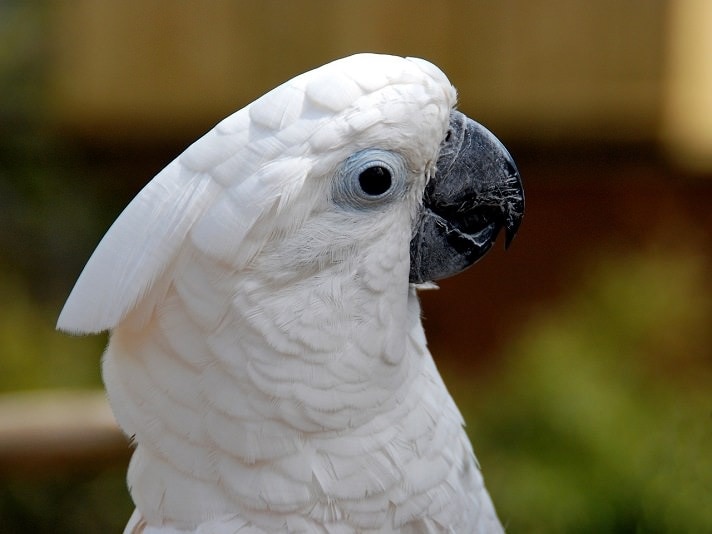Pet Bird Noise 101

Photo by Chewy
You’ve read the books, you’ve searched online and talked to whomever you could to make sure your new pet bird will be a good match. Then you get your new parrot home and start to wonder when your landlord or neighbor might be knocking at your door because of the noise. What did you get yourself into? The following information just may help you live peacefully with your bird and your neighbors.
With the possible exception of cockatiels, lovebirds and budgerigars (budgies or “parakeets”), no parrot species meets the description of a domesticated pet. They are usually only one, two or three generations removed from the wild and are not genetically different from their wild cousins. A hand-raised parrot will not have identical vocalizations to its wild cousins, but their sounds will be similar in patterns and purpose.
How Parrots "Grow" Their Noise
As babies, parrots tend to be quiet. Most only vocalize to evoke feeding. As they start to mature and become their own little beings, they begin to learn they have a voice. Many people think that when they bring a young pet bird home, the bird will always be quiet like it was as a baby. Not true. Noise is quickly becoming the primary behavioral issue that parrot behavioral consultants encounter today, and it is a huge factor as to why some birds lose their homes.
Pet birds can be expected to make noise on and off during the day, usually with a steady pattern to the noise. The loudest times are often at dawn and dusk. These times can be considered contact calls to flock members.
The morning vocalization is a celebration of surviving another night, announcing territory, and let’s all gather to be social and eat. The day is spent foraging for food and flying, with sporadic interactions on and off. There are some down times and some rest periods, generally in the hottest time of day.
The other loud burst of noise often occurs again as night falls. Vocalization at this time of day may be from a combination of factors depending on the flock; as certified-parrot behavior consultant and director of the Anchorage, AK chapter of PEAC, Karen Webster said, “It could be a welcome home to a flock member, the typical nightly roll call to flock members to say, ‘Is anyone missing, we are going to sleep now. If you’re not close by, get your tail feathers over here.'”
We as owners need to learn to distinguish the different types of vocalization and their meaning. It is our birds’ way of communicating with us, and we must take time to understand it. If we choose to ignore their communication, it is likely to contribute to further behavioral issues down the road. Learning to read body language is also crucial to understanding overall communication with your bird.
There is always a reason for the vocalization of our parrots; warning, contact, etc. Be familiar with the daily noise so you can tell when something is out of the ordinary. For example, a lack of vocalization can mean illness, while an overabundance can mean distress.
It’s difficult to generalize a species since they are, like people, individuals. This article can be used as a general guide to noise levels and what you can expect.
Many Amazon parrots are known to have a remarkable ability to mimic human speech along with other sounds. Some Amazon species are more vocal than others. The orange-winged and lilac-crowned Amazons are among the quieter members of the genus Amazona, whereas the double yellow-headed, yellow-naped and blue-fronted Amazons tend to be the noisier members of the species.
Generally speaking, the loudest family of parrots are the cockatoos. Moluccan cockatoos are noted to be the loudest cockatoo species and the citron-crested cockatoo the quietest. It should be mentioned however, that no cockatoo is truly quiet. According to the cockatoo website mytoos.com, “A 747 Jumbo Jet produces as much as 140 decibels of noise. 105db is considered damaging to the ear. Peacocks have been registered at 115, Moluccans hold the record as the loudest bird on earth at 135db (average = 120db).”
We usually think of ear-splitting noises as coming from the larger species like macaws and cockatoos. They can be very loud and heard up to 5 miles away. They use their voice to call flock members across miles of dense jungles. Their vocalization, however, usually lasts 20 to 25 minutes in the morning and evening. That can be more tolerable to some people than a conure, lovebird or parrotlet that doesn’t seem to have an off button all day. It comes down to the individual owners as it does the species and bird. Garry Wallan, aviculturist and operator of Old World Aviaries in Texas, cheerfully mentioned this while thinking of his own flock,” One person’s sweet tweet of avian innocence is another’s grating screech.”
For a little more information on decibels, Kashmir Csaky, a certified-parrot behavior consultant and chair of the parrot division of the International Association of Animal Behavior Consultants, did an experiment with her flock of hyacinth macaws to assist me with the research for this article.
“The intensity of sound in watts per square meter is twice as high in increments of three decibels. So, 103 decibels (dB) is twice as intense as 100 decibels. For the human ear to perceive the sound as twice as loud it has to be 10 dB higher,” said Csaky. “My bird rooms have concrete floors, drywall or wood walls. There is little to absorb sound. With all the birds making virtually no noise and the radio playing, the sound level was 55 to 60 dB. A macadamia nut shell dropped to the metal tray of a playgym was 80 dB. Once birds began screaming the level was 100 to 104 dB. Hyacinth macaw alarm calls were 106 dB. A scarlet macaw measured at 102 dB from 15 feet away. I also measured the sound from outside. When it was 100 to 104 dB inside, outside — with windows and doors closed — the measurement dropped to 75 dB and that was one foot from the door.”
On a whimsical note, Csaky added that her sneezes were 95 dB.
It is also known that many parrots enjoy noise and will often try to top whatever is happening in the house. Don’t expect to have a loud television, barking dogs, or screaming kids and a quiet parrot.
Species-Noise Levels
Cockatiel, budgerigar (budgie), lovebird and parrotlet owners said most were chatty all day. None were reported to get out of the tolerable range. It didn’t seem to appear that they would bother any neighbor, with the exception of an overly loud cockatiel contact call. Pionus and Poicephalus owners (i.e., Senegal parrots, Meyer’s parrots) noted that their species were known to be on the quieter side. Most cockatoo and macaw owners noted the extreme loudness at certain times of day. Amazon and African grey owners noted more human speech being used to engage in cognitive communication. The loudest alarm warnings came from macaws, but also conures, Eclectus and African greys.
It was interesting to find that size isn’t always the determining factor for tolerable noise. Some of the loudest birds according to the polls were birds in smaller bodies. Conures ranked at No. 1 for overall loudness, as well as frequency for contact calls, greetings and alarm calls.
Jennifer Jassar from Jordan wrote, “When I was 18, I owned a nanday conure. He was so affectionate and loving. But, as far as the noise level, I used to get complaints from the neighbors in my apartment building. He used to make this call at 6 AM every morning, even if I had him in a dark room, that woke everyone up! I used to just look at him and wonder how that loud noise could come out of such a small little thing.”
Leslie Wood from New Jersey commented, “Sunny is a re-homed sun conure. Her first owner said she was too loud. Sunny was 5 when we got her, and she is now 16. Loud is a relative term. She is fairly quiet with her daily chattering noise. She is enthusiastic when she plays, and if she gets mad at her bird toys she will yell at them. With a sun conure in the house, there is no need for an alarm system. Be it a cat in the yard, an unfamiliar car on the street, or someone at the door, my sun conure lets me know with her ‘nuclear alert.’ It is a distinctly different squawk and very piercing. More often than not, she is correct in alerting me to something that is not right.”
While researching noise levels and vocalizations, I also contacted adoption and sanctuary organizations to ask which were the loudest species relinquished and were the hardest species to re-home.
The results for both questions:
- Cockatoos
- Conures
- Macaws
Sybil Erden and Janet Trumbule from The Oasis in Arizona; Matt Smith, director of The Central Virginia Parrot Sanctuary; and Marc Johnson of Foster Parrots Ltd in Rhode Island, agreed they see many conure species relinquished due to noise.
Irena Schulz, founder of Bird Lovers Only Rescue, mentioned that she has noticed an increase in cockatiels coming in due to noise. Schulz said, “The hardest to place due to noise are, of course, the cockatoos and macaws. The conures and cockatiels are much easier to place on many levels. They can become as hormonal, aggressive, destructive, and noisy as the larger birds, but because of their size they seem to be viewed as more handleable.”
Living With Parrot Noise
How do you achieve a harmonious household with a loud parrot? First, do your homework. Understand the species you are considering bringing home. Prevent problems from arising by building a strong foundation of rewarding sounds you like and ignoring sounds you don’t like. Work on correcting issues as soon as they arise. Don’t let them get out of hand before addressing them. Problematic behaviors will not go away on their own.
Parrots will often learn to produce loud vocalizations to receive desired responses they want, like attention from their owners. This is a learned vocalization and easier to extinguish with behavior modification and positive reinforcement techniques. An undesired word or sound can be morphed into an acceptable form of vocalization. This will require patience and consistency from all members of the family. Always remember to reward with positive reinforcement after desired vocalization is achieved.
The sound level you can consider appropriate and ideal will be dictated by the species and what you are willing to live with. A known vocal species will not do well in a community of close homes like townhomes or apartments. Please keep that in mind when selecting your species so your bird does not have to pay the ultimate price of losing its home. An excellent way to hear adult birds vocalizing naturally is to volunteer at a rescue or sanctuary in your area.
You cannot train your parrots to be quiet, nor should you expect them to be. Parrots are vocal by nature. We need to understand and accept the vocalizations as a part of parrot ownership.
Should you find yourself needing help with a screaming problem and your avian veterinarian has cleared the bird from any medical issues, check the directory for parrot behavior consultants found in the International Association of Animal Behavior Consultants.
Natural Noises
- Morning greetings
- Daily chatter
- Happy-to-be-alive outbursts
- Contact calls
- Evening greetings
- Bedtime chatter
- Alarm calls
Posted by: Chewy Editorial
Featured Image: Gilliane/Pixabay



